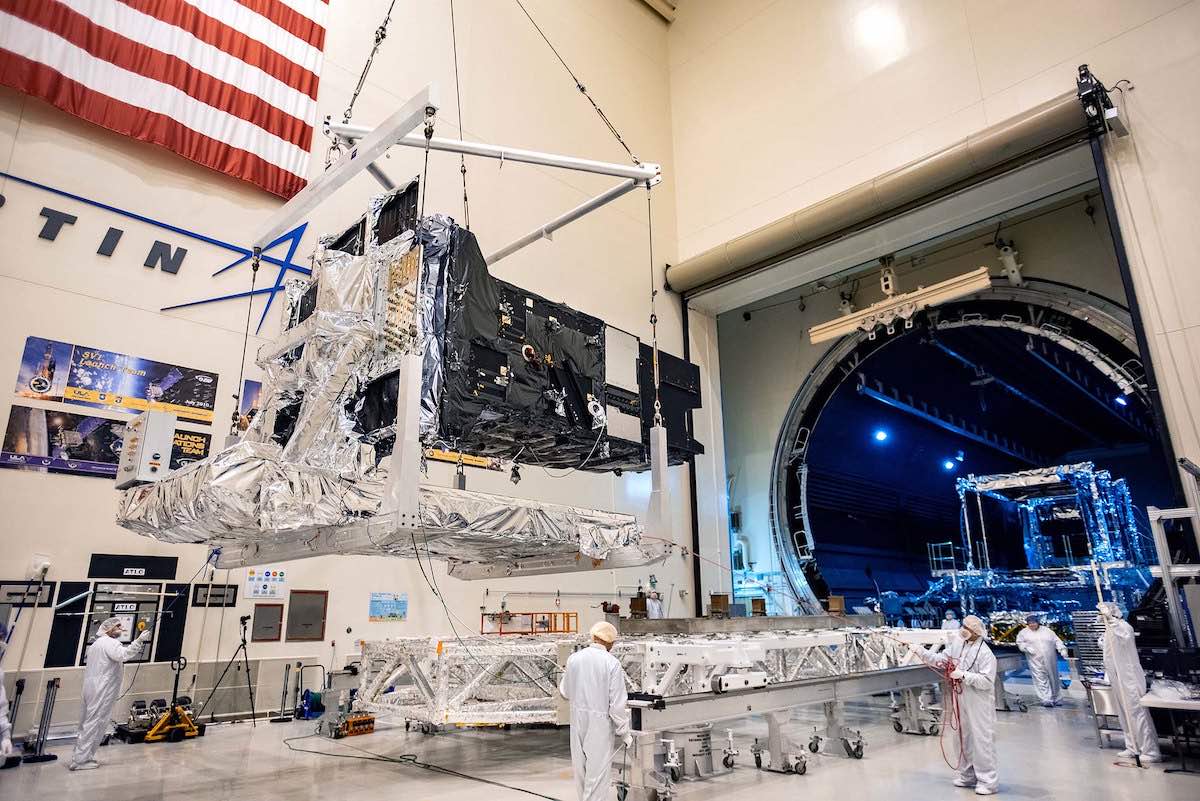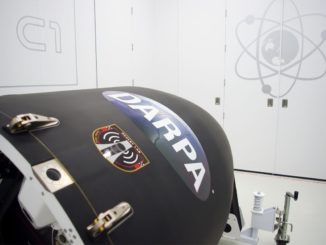
A billion-dollar missile warning satellite built by Lockheed Martin for the U.S. Space Force arrived at Cape Canaveral earlier this month to kick off final preparations for launch May 17 aboard a United Launch Alliance Atlas 5 rocket.
The military’s fifth Space Based Infrared System, or SBIRS, satellite designed to operate in geosynchronous orbit arrived at the Florida launch base March 18 on a U.S. Air Force C-17 cargo plane, officials announced Wednesday.
The SBIRS GEO 5 spacecraft shipped to Florida from its Lockheed Martin factory in Sunnyvale, California, where teams completed construction of the satellite last October. SBIRS GEO 5 is follows four previous SBIRS satellites launched into geosynchronous orbit since 2011 to replace the military’s aging Defense Support Program missile warning spacecraft, the last of which launched in 2007.
The new satellite differs from the first four SBIRS GEO satellites, introducing an upgraded spacecraft design Lockheed Martin calls the “combat bus.” Lockheed Martin built the fifth and sixth SBIRS GEO satellites using its new LM 2100 platform, which the company says is the result of an “internally-funded, multi-year modernization initiative.”
According to Lockheed Martin, the LM 2100 combat bus is designed to provide improved resiliency and hardening against cyber threats, along with additional spacecraft power, and enhanced propulsion and electronics. The modular design incorporates common components to streamline manufacturing, and can more easily accommodate new types of sensors to respond to innovation and new military requirements.
The LM 2100 combat bus will also be used by the next generation of missile warning satellites Lockheed Martin is building for the Space Force to replace the SBIRS fleet. The next generation of GPS navigation satellite, due to begin launching in 2026, will also use the combat bus platform.
The final SBIRS GEO satellite, GEO 6, is scheduled of launch on an Atlas 5 rocket in 2022. The military’s contracts with Lockheed Martin for the final two SBIRS GEO satellites are valued at about $2.2 billion, according to financial data published by the Pentagon in previous years.
Northrop Grumman builds the infrared sensors on the SBIRS satellites. The instruments can detect and track super-hot exhaust plumes from rocket motors, informing military officials of foreign missile launches. The information gathered by the SBIRS fleet could help defense units intercept an incoming missile before it strikes its target.
The SBIRS constellation includes a minimum of four SBIRS craft stationed in geosynchronous orbit and at least two infrared payloads in elliptical orbits aboard top secret National Reconnaissance Office spy satellites, providing polar coverage. The final two SBIRS satellites set for launch this year and next year will replenish the fleet.
Each infrared instrument package on the geosynchronous satellites includes staring and scanning sensors designed to provide visibility over an entire hemisphere, while allowing ground operators to focus the craft’s gaze on hotspots like North Korea.
The satellites in geosynchronous orbit fly more than 22,000 miles (nearly 36,000 kilometers) over the equator, and remain over the same geographic location on Earth 24 hours a day.
With SBIRS GEO 5 now at Cape Canaveral, technicians will ready the satellite for launch. Major steps over the coming weeks will be a post-shipment functional test to verify the satellite is in good health after the cross-country trip from California, followed by loading of hydrazine and nitrogen tetroxide propellants for in-space maneuvers.
Ground crews will then encapsulate the SBIRS GEO 5 spacecraft inside the Atlas 5 rocket’s 13.1-foot-diameter (4-meter) payload fairing and transport the satellite to United Launch Alliance’s Vertical Integration Facility for hoisting on top of the launcher.
ULA will begin stacking the Atlas 5 rocket on its mobile launch platform inside the VIF next month.
The launch company — a 50-50 joint venture between Boeing and Lockheed Martin — is also testing a pathfinder version of its next-generation Vulcan booster at Cape Canaveral amid a series of Atlas 5 launches this year.

The Atlas 5 launcher that will deliver the SBIRS GEO 5 spacecraft to orbit will fly in the “421” configuration with a 4-meter and two strap-on solid rocket boosters supplied by Aerojet Rocketdyne. A single RL10 engine from Aerojet Rocketdyne will power the Atlas 5’s Centaur upper stage.
The launch will mark the eighth flight of the Atlas 5-421 variant, and the 87th launch of an Atlas 5 rocket since its debut in 2002.
It will be the first Atlas 5 flight since last November.
ULA plans up to eight Atlas 5 missions this year, including the launch of SBIRS GEO 5 scheduled for May 17. Another Atlas 5 rocket is scheduled to take off from Cape Canaveral in late June with a pair of spacecraft managed by the military’s Space Test Program, which oversees some of the Pentagon’s experimental space missions.
The late June launch target for the Space Test Program-3 mission was disclosed this week by acting NASA administrator Steve Jurczyk. NASA has a laser communications technology demonstration payload on one of the two Space Force satellites flying on the STP-3 launch.
Atlas 5 missions planned for launch from Cape Canaveral in the second half of this year include unpiloted and piloted test flights of Boeing’s Starliner crew capsule, which is designed to ferry astronauts to and from the International Space Station. Two more satellites will launch on an Atlas 5 later this year for the Space Force’s Geosynchronous Space Situational Awareness Program, followed by Atlas 5 launches with NASA’s Lucy asteroid mission and NOAA’s next GOES weather satellite in October and December.
The sole Atlas 5 launch this year from Vandenberg Air Force Base in California is scheduled for September. It will carry the Landsat 9 Earth observation satellite for NASA and the U.S. Geological Survey.
ULA’s other two missions scheduled for 2021 are the launch of a Delta 4-Heavy rocket from Vandenberg no earlier than April 26 with a classified spy satellite for the National Reconnaissance Office, and the inaugural test flight of the new Vulcan Centaur rocket from Cape Canaveral at the end of the year.
Email the author.
Follow Stephen Clark on Twitter: @StephenClark1.



